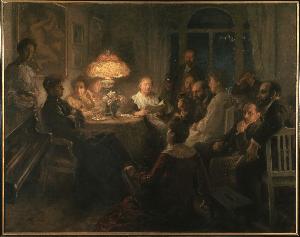Hanna Hirsch
Hanna Hirsch;Pauli
Place: Stockholm
Born: 1864
Death: 1940
Biography:
Early Life and Education
Hanna Hirsch, later Hanna Pauli (Stockholm, 13 January 1864 – 29 December 1940, Solna), was a Swedish painter primarily of genre scenes and portraits. Born in Stockholm, Sweden, Hirsch received her early education at the August-Malström school of painting for women.
Artistic Career
Hanna Hirsch's artistic career began with studies at the Konstakademien (1881-85) and later in Paris, where she honed her skills. Her work is characterized by its focus on genre scenes and portraits, often depicting the lives of women and their daily routines.
- Breakfast-Time (1887), a painting showcasing a moment of domesticity, is one of her most notable works. This piece can be found in the Nationalmuseum (Stockholm, Sweden) and is a testament to Hirsch's ability to capture the essence of everyday life.
- Vänner (circa 1890), another significant work, highlights her skill in portraying the warmth of friendships. This painting is also housed at the Nationalmuseum.
Feminism and Art
Hirsch's work not only showcases her artistic prowess but also reflects her feminist stance.Her depictions of women in their daily lives, free from the constraints of traditional roles, are a testament to her progressive views. This is particularly evident in her letters written during her study trips to Paris (1885-87), which offer a unique insight into her experiences as a woman artist in a male-dominated field.
Legacy and Resources
For those interested in delving deeper into Hanna Hirsch's life and work, the following resources are recommended:
- WikiArt.org: Provides an extensive collection of her artworks.
- Wikipedia: Offers a concise biography and overview of her artistic career.
- Nationalmuseum's Collection: Features several of her notable works, including Breakfast-Time and Vänner.
Conclusion
Hanna Hirsch's legacy as a Swedish painter is not only marked by her captivating genre scenes and portraits but also by her contribution to the feminist movement through her art. Her work continues to inspire, offering a unique window into the lives of women in late 19th-century Sweden.


